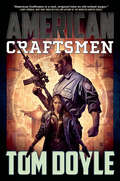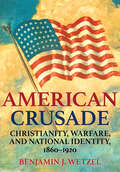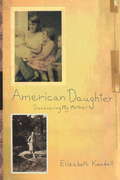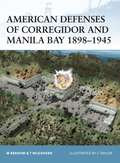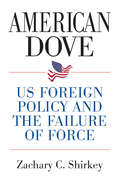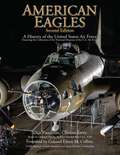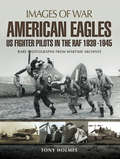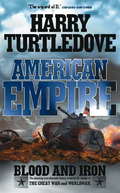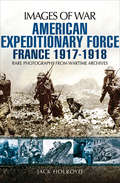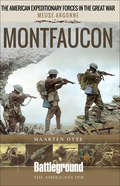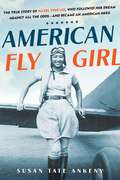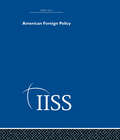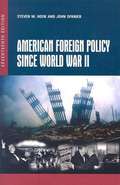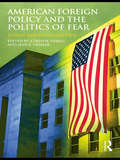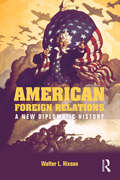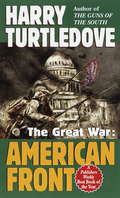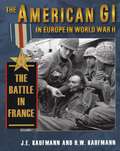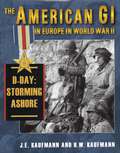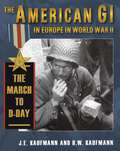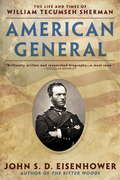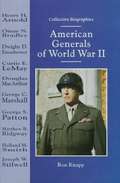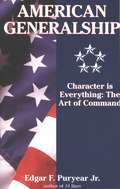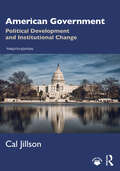- Table View
- List View
American Craftsmen: A Novel (American Craft Ser. #1)
by Tom DoyleIn modern America, two soldiers will fight their way through the magical legacies of Poe and Hawthorne to destroy an undying evil—if they don't kill each other first.US Army Captain Dale Morton is a magician soldier—a "craftsman." After a black-ops mission gone wrong, Dale is cursed by a Persian sorcerer and haunted by his good and evil ancestors. Major Michael Endicott, a Puritan craftsman, finds gruesome evidence that the evil Mortons, formerly led by the twins Roderick and Madeline, have returned, and that Dale might be one of them.Dale uncovers treason in the Pentagon's highest covert ranks. He hunts for his enemies before they can murder him and Scherie, a new friend who knows nothing of his magic.Endicott pursues Dale, divided between his duty to capture a rogue soldier and his desire to protect Dale from his would-be assassins. They will discover that the demonic horrors that have corrupted American magic are not bound by family or even death itself. In Tom Doyle's thrilling debut, American Craftsmen, Seal Team Six meets ancient magic--with the fate of the United States hanging in the balance . . .The American Craft Trilogy#1 American Craftsmen#2 The Left-Hand Way#3 War and CraftAt the Publisher's request, this title is being sold without Digital Rights Management Software (DRM) applied.
American Crusade: Christianity, Warfare, and National Identity, 1860–1920
by Benjamin J. WetzelWhen is a war a holy crusade? And when does theology cause Christians to condemn violence? In American Crusade, Benjamin Wetzel argues that the Civil War, the Spanish-American War, and World War I shared a cultural meaning for white Protestant ministers in the United States, who considered each conflict to be a modern-day crusade. American Crusade examines the "holy war" mentality prevalent between 1860 and 1920, juxtaposing mainline Protestant support for these wars with more hesitant religious voices: Catholics, German-speaking Lutherans, and African American Methodists. The specific theologies and social locations of these more marginal denominations made their ministries highly critical of the crusading mentality. Religious understandings of the nation, both in support of and opposed to armed conflict, played a major role in such ideological contestation. Wetzel's book questions traditional periodizations and suggests that these three wars should be understood as a unit. Grappling with the views of America's religious leaders, supplemented by those of ordinary people, American Crusade provides a fresh way of understanding the three major American wars of the late nineteenth and early twentieth centuries.
American Daughter
by Elizabeth KendallIn this beautifully crafted book, Elizabeth Kendall tells the story of a family, of a passionate attachment between a mother and a daughter and the sudden tragedy that tears it apart. American Daughter is also a brilliant portrait of wellborn women's lives in cities and towns in the post-World War II era, as Kendall evokes how difficult it was to become anything other than an American daughter, which meant being a dependent woman. Occupying a coveted place in St. Louis's privileged high society, Henry and Betty Kendall seemed to be the American dream come true: six children, a sprawling house, a legacy of higher education at Harvard and Vassar. Yet underneath lay the flawed marriage of an idealistic young woman who made her eldest daughter her best friend and turned civil rights into her salvation. Elizabeth maintained the family silence as eccentricities began to appear in her father's behavior, along with whispers of financial difficulties. She accompanied her mother back to Vassar for a summer program on the home and family, then came into her own, away from her family, at the haven of a girls' summer camp and at Radcliffe. From the war-torn 1940s, when young men in uniform, home on leave, went to debutante parties, through the seismic social changes of the 1960s, Kendall tells the intertwined story of her mother and herself, of their powerful bond and how both shaped their lives in response to it. Unrelentingly honest, rich with humor and insights into families and women's lives, American Daughter is both a poignant portrait of American life at the middle of the twentieth century, and a dual coming-of-age story of a mother and a daughter, united by commitment and love, separated by a fatal accident-and by the vastly different birthrights of their generations.From the Hardcover edition.
American Daughter Gone to War: On the Front Lines with an Army Nurse in Vietnam
by Winnie SmithA former member of the Army Nurse Corps in Vietnam recalls her tour of duty and her difficult adjustment to civilian life.
American Defenses of Corregidor and Manila Bay 1898-1945
by Chris Taylor Mark BerhowThe Philippines were declared an American Territory on January 4, 1899, and fortification construction soon began on the islands in the mouth of Manila Bay. Among the sites built were Fort Mills (Corregidor), Fort Frank, and the formidable "concrete battleship" of Fort Drum. The defenses suffered constant Japanese bombardment during World War II, leading to the surrender of American forces. In 1945 the forts were manned by Japanese soldiers determined to hold out to the bitter end. This title details the fortifications of this key strategic location, and considers both their effectiveness and historical importance.
American Dove: US Foreign Policy and the Failure of Force
by Zachary ShirkeyZachary C. Shirkey argues that the United States is overly reliant on the active use of force and should employ more peaceful foreign policy tools. Force often fails to achieve its desired ends for both tactical and strategic reasons and is relatively infungible, making it an inappropriate tool for many US foreign policy goals. Rather than relying on loose analogies or common sense as many books on US grand strategy do, American Dove bases its argument directly on an eclectic mix of academic literature, including realist, liberal, and constructivist theory as well as psychology. Shirkey also argues against retrenchment strategies, such as offshore balancing and strategic restraint as lacking a moral component that leaves them vulnerable to hawkish policies that employ moral arguments in favor of action. US withdrawal would weaken the existing liberal international security, economic, and legal orders—orders that benefit the United States. Rather, the book argues the United States needs an energetic foreign policy that employs passive uses of force such as deterrence and nonmilitary tools such as economic statecraft, international institutions, international law, and soft power. Such a policy leaves room for a moral component, which is necessary for mobilizing the American public and would uphold the existing international order. Last, Shirkey argues that to be successful, doves must frame their arguments in terms of strategy rather than in terms of costs and must show that dovish policies are consistent with national honor and a broad range of American values. American Dove offers a framework for US grand strategy and a plan for persuading the public to adopt it.
American Eagles: A History of the United States Air Force Featuring the Collection of the National Museum of the U.S. Air Force
by Dan Patterson Clinton TerryFeaturing the collection of airplanes, art, photographs, and memorabilia of the National Museum of the U.S. Air Force at Wright-Patterson Air Force Base near Dayton, Ohio, this magnificently illustrated book tells the story of the beginnings of flight, through the creation of the U.S. Air Force as a separate branch of the military, to the unbelievable technological achievements of what is the preeminent air power in the world today. Here are combat aces, Medal of Honor recipients, crusty generals, and average citizens who served in the Air Force. There are philosophers, airplane designers, test pilots, rocket scientists, armorers, and grease monkeys. More than 250 color and 150 black-and-white illustrations and photos and insightful text present the story of the U.S. Air Force of yesterday, today, and tomorrow, published on the occasion of the seventy-fifth anniversary of the United States Air Force and the one hundredth anniversary of the National Museum of the U.S. Air Force.
American Eagles: Rare Photographs From Wartime Archives (Images of War)
by Tony HolmesAmerican Eagles provides a photographic snapshot of the lives of the American fighter pilots who volunteered their services during World War II, as well as the Spitfires and Hurricanes they flew. Keen to help Britain stem the spread of Fascism, or perhaps seeking adventure in a foreign land, a number of American citizens defied the wishes of their government by crossing the border into Canada and subsequently sailing to Britain to join the Royal Air Force. Some were prewar civilian pilots, others were rich playboys and a few were already serving in the RAF when war was declared. Men such as Don Blakeslee, Billy Fiske, 'Gus' Daymond and Jim Dunn, as well as many other notable pilots are featured in this volume, in photographs that have been carefully sourced from official and private archives across the globe. Each image has a detailed caption, chronicling the wartime exploits of the elite 'band of brothers' known as the American Eagles.
American Empire: Blood and Iron
by Harry TurtledoveThe first volume of the American Empire trilogy from Harry Turtledove, "The Wizard of If".As Turtledove's brilliant series The Great War came to its end, the United States of America, in alliance with Germany, had defeated Great Britain, France and the Confederate States of America in a bloody conflict known as the First World War.Now as the 1920s begin, though, the seeds of a new conflict have already been sown. The United States, led by Theodore Roosevelt, swings wildly towards socialism. In Canada - now a US colony - nationalist terrorists strike against the new American oppressors. But it is in the Confederacy, trapped in a ruinous economic depression, where fascism begins to spread, and the fires are fanned by a charismatic leader who may again plunge the world into war.
American Expeditionary Force: France, 1917–1918 (Images of War)
by Jack HolroydWhen the United States entered the war in April 1917 the belligerents were approaching exhaustion. It had been hoped by the Generals in both Britain and France that untold numbers of fresh troops would be assimilated into their respective commands. However, this idea was firmly resisted, America would field its own army alongside the Allies it would have its own section on the front line. Those with concerns that the untried divisions under General Pershing would fair badly against the seasoned German military machine were soon reassured as impressive victories were won by the newcomers. The book is split into eight chapters which deal with different pivotal moments during the First World War from the American perspective, from the reasons behind the American involvement in the war and initial training to the major battles at Cantigny, Chateau Thierry and St. Mihiel. This story is told in pictures gleaned from the official archives which were first published in 1920 and now presented for reexamination and public awareness in the Images of War series.
American Expeditionary Force: France, 1917–1918 (Images of War)
by Jack HolroydWhen the United States entered the war in April 1917 the belligerents were approaching exhaustion. It had been hoped by the Generals in both Britain and France that untold numbers of fresh troops would be assimilated into their respective commands. However, this idea was firmly resisted, America would field its own army alongside the Allies it would have its own section on the front line. Those with concerns that the untried divisions under General Pershing would fair badly against the seasoned German military machine were soon reassured as impressive victories were won by the newcomers. The book is split into eight chapters which deal with different pivotal moments during the First World War from the American perspective, from the reasons behind the American involvement in the war and initial training to the major battles at Cantigny, Chateau Thierry and St. Mihiel. This story is told in pictures gleaned from the official archives which were first published in 1920 and now presented for reexamination and public awareness in the Images of War series.
American Expeditionary Forces in WWI: Montfaucon (Battleground Books: Wwi Ser.)
by Maarten OtteAny visitor to the site of the bloodiest battle in the history of the United States will be drawn to Montfaucon, for it is here that General Pershing, the Commander in Chief, determined that the major memorial to the American Expeditionary Forces would be sited. The impressive classical column, erected on the summit of Montfaucon Hill, can be seen from many parts of the battlefield of the Meuse-Argonne 1918.The village of Montfaucon, perched on and around one of the most notable heights in the Argonne area, was a first day objective for the First American Army in its massive offensive that was launched on 26 September 1918 and which rumbled on until the Armistice.Montfaucon had been the scene of bitter fighting between the French and the Germans in the early stages of the war, finally staying securely in German hands. The attack started well, with the great numbers of Doughboys easily moving through the first line of the German defense system; and, indeed, good progress was made all along the front, even if final objectives were not attained that would have brought the Americans up to the Hindenburg Line defenses. The most notable setback was the failure to capture Montfaucon, an objective given to the 79th Division. Why the task of capturing this key part of the German line to a 'green' division, composed of draftees and which had only had six weeks or so of training time in France, instead of the prescribed three months, has never been adequately explained.What has proved to be controversial ever since is why the 4th Division, a regular formation that had already been engaged in battle on the Western Front and which gained its objectives on the first day, did not seek to assist the 79th when it was clear that it was facing significant difficulties in overcoming the Montfaucon defenses. The outcome was that the village and hill did not fall on the first day. How significant this setback was to the success and the duration of the offensive has also been the subject of considerable discussion.Montfaucon was an important observation point for much of the war, providing distant views over considerable amounts of ground and thus invaluable for the German artillery. How much its loss mattered to the Germans when fighting a defensive battle, with the defense lines south of it already lost, is more open to debate, given the vantage points that the Germans continued to enjoy from high ground to the north-west and east.Maarten Otte sets the importance of Montfaucon and the ultimately successful effort to capture it within a succinct narrative. In the tours section he takes the visitor on a number of routes so that they can see for themselves the problems on the ground that faced the 79th Division and puts Montfaucon in the context of the wider battle. He also provides a detailed tour of the village and hill itself, including the magnificent memorial and the preserved defenses and ruins which surround it.
American Flygirl
by Susan Tate AnkenyOne of WWII&’s most uniquely hidden figures, Hazel Ying Lee was the first Asian American woman to earn a pilot&’s license, join the WASPs, and fly for the United States military amid widespread anti-Asian sentiment and policies.Her singular story of patriotism, barrier breaking, and fearless sacrifice is told for the first time in full for readers of The Women with Silver Wings by Katherine Sharp Landdeck, A Woman of No Importance by Sonia Purnell, The Last Boat Out of Shanghai by Helen Zia, Facing the Mountain by Daniel James Brown and all Asian American, women&’s and WWII history books. In 1932, Hazel Ying Lee, a nineteen-year-old American daughter of Chinese immigrants, sat in on a friend&’s flight lesson. It changed her life. In less than a year, the girl with the wicked sense of humor, a newfound love of flying, and a tough can-do attitude earned her pilot&’s license and headed for China to help against invading Japanese forces. In time, Hazel would become the first Asian American to fly with the Women Airforce Service Pilots. As thrilling as it may have been, it wasn&’t easy. In America, Hazel felt the oppression and discrimination of the Chinese Exclusion Act. In China&’s field of male-dominated aviation, she was dismissed for being a woman, and for being an American. But in service to her country, Hazel refused to be limited by gender, race, or impossible dreams. Frustrated but undeterred, she forged ahead, married Clifford Louie, a devoted and unconventional husband who cheered his wife on, and gave her all for the cause, achieving more in her short, remarkable life than even she had imagined possible. American Flygirl is the untold account of a spirted fighter and an indomitable hidden figure in American history. She broke through every common belief about women. She challenged every social restriction to endure and to succeed. And against seemingly insurmountable obstacles, Hazel Ying Lee reached for the skies and made her mark as a universal and unsung hero whose time has come.
American Foreign Policy (Adelphi Papers Reissue Hardback)
by variousComplete set Since 1961 the Adelphi Papers have provided some of the most informed accounts of international and strategic relations. Produced by the world renowned International Institute of Strategic Studies, each paper provides a short account of a subject of topical interest by a leading military figure, policy maker or academic. The project reprints the first forty years of papers, arranged into thematic sets. The collection as a whole provides a rich and insightful account of international affairs during a period which spans the second half of the Cold War, the fall of the communist bloc and the emergence of a new regime with the United States as the sole superpower. There is a wealth of global coverage: Four volumes on east and southeast Asia as well as individual volumes on China, Japan and Korea Particular attention is given to the Middle East, with volumes addressing internal sources of instability; geo-politics and the role of the superpowers; the Israel-Palestine conflict; and the Iran-Iraq War and the first Gulf War. There is also a volume on oil and insecurity There are also two volumes on Africa, the site of most of the world’s wars during the period. The IISS has obviously made a particular contribution to the understanding of military strategy, and this is reflected with material on topics such as urban and guerrilla warfare, nuclear deterrence and the role of information in modern warfare. Volumes on military strategy are complemented by approaches from other disciplines, such as defence economics. Key selling points: Early papers were only distributed by the IISS and will have achieved limited penetration of the academic market A host of major authors on a range of different subjects (eg Gerald Segal on China, Michael Leifer on Southeast Asia, Sir Lawrence Freidman on the revolution in military affairs, Raymond Vernon on multinationals and defence economics) Individual volumes will have a strong appeal to different markets (eg the volume on defence economics for economists, various volumes for Asian Studies etc)
American Foreign Policy Since World War II (17th Edition)
by Steven W. Hook John SpanierThe United States remains engaged in an open-ended "war on terrorism" with no foreseeable endpoint.
American Foreign Policy and The Politics of Fear: Threat Inflation since 9/11 (Routledge Global Security Studies)
by A. Trevor Thrall Jane K. CramerThis edited volume addresses the issue of threat inflation in American foreign policy and domestic politics. The Bush administration's aggressive campaign to build public support for an invasion of Iraq reheated fears about the president's ability to manipulate the public, and many charged the administration with 'threat inflation', duping the news media and misleading the public into supporting the war under false pretences. Presenting the latest research, these essays seek to answer the question of why threat inflation occurs and when it will be successful. Simply defined, it is the effort by elites to create concern for a threat that goes beyond the scope and urgency that disinterested analysis would justify. More broadly, the process concerns how elites view threats, the political uses of threat inflation, the politics of threat framing among competing elites, and how the public interprets and perceives threats via the news media. The war with Iraq gets special attention in this volume, along with the 'War on Terror'. Although many believe that the Bush administration successfully inflated the Iraq threat, there is not a neat consensus about why this was successful. Through both theoretical contributions and case studies, this book showcases the four major explanations of threat inflation -- realism, domestic politics, psychology, and constructivism -- and makes them confront one another directly. The result is a richer appreciation of this important dynamic in US politics and foreign policy, present and future. This book will be of much interests to students of US foreign and national security policy, international security, strategic studies and IR in general. Trevor Thrall is Assistant Professor of Political Science and directs the Master of Public Policy program at the University of Michigan - Dearborn. Jane Kellett Cramer is an Assistant Professor of Political Science at the University of Oregon.
American Foreign Relations: A New Diplomatic History
by Walter L. HixsonAmerican Foreign Relations: A New Diplomatic History is a compelling narrative history of American foreign policy from the early settlement of North America to the present. In addition to economic and strategic motives, Walter L. Hixson integrates key cultural factors--including race, gender, and religion--into the story of American foreign policy. He demonstrates how these factors played a vital role in shaping the actions of the United States in world affairs. Beginning with the history of warfare and diplomacy between indigenous peoples and Europeans before the establishment of the United States, this book shows the formative influence of settler colonialism on the country's later foreign policy and the growth of American empire. Clearly written and comprehensive, the book features: Extensive illustrations, with over 100 images and maps Primary documents in each chapter, showcasing the perspectives of historical actors "Interpreting the Past" features that explore how historians' understanding of events has changed over time Selected bibliographies of key resources for further research in each chapter In one concise volume, American Foreign Relations covers the full sweep of American foreign policy from the colonial period to the present day. It is an essential introduction for anyone seeking to understand the history of America's role in the world.
American Front: American Front (Southern Victory: The Great War #1)
by Harry TurtledoveWhen the Great War engulfed Europe in 1914, the United States and the Confederate States of America, bitter enemies for five decades, entered the fray on opposite sides: the United States aligned with the newly strong Germany, while the Confederacy joined forces with their longtime allies, Britain and France. But it soon became clear to both sides that this fight would be different--that war itself would never be the same again. For this was to be a protracted, global conflict waged with new and chillingly efficient innovations--the machine gun, the airplane, poison gas, and trench warfare.Across the Americas, the fighting raged like wildfire on multiple and far-flung fronts. As President Theodore Roosevelt rallied the diverse ethnic groups of the northern states--Irish and Italians, Mormons and Jews--Confederate President Woodrow Wilson struggled to hold together a Confederacy still beset by ignorance, prejudice, and class divisions. And as the war thundered on, southern blacks, oppressed for generations, found themselves fatefully drawn into a climactic confrontation . . .From the Paperback edition.
American GI in Europe in World War II The Battle in France
by H. W. Kaufmann J. E. KaufmannFirsthand accounts and contextual narrative chronicling the war in Europe after D-Day. Sidebars on glider operations, rear-area activities, hedgerow country, and more. Based on interviews with more than 200 veterans.
American GI in Europe in World War II: D-Day: Storming Ashore
by H. W. Kaufmann J. E. KaufmannCovers the D-Day airborne drops and amphibious landings at Omaha Beach and Utah Beach. Includes sidebars on landing craft, the naval bombardment, engineers, medics, the Germans' defenses, and more.
American GI in Europe in World War II: The March to D-Day
by H. W. Kaufmann J. E. KaufmannFirsthand accounts and contextual narrative chronicling the U.S. war effort before D-Day. Sidebars on patrols, service troops, the replacement system, Rangers, and more. Based on interviews with more than 200 veterans.
American General
by John S.D. EisenhowerFrom respected historian John S. D. Eisenhower comes a surprising portrait of William Tecumseh Sherman, the Civil War general whose path of destruction cut the Confederacy in two, broke the will of the Southern population, and earned him a place in history as "the first modern general." Yet behind his reputation as a fierce warrior was a sympathetic man of complex character. A century and a half after the Civil War, Sherman remains one of its most controversial figures--the soldier who brought the fight not only to the Confederate Army, but to Confederate civilians as well. Yet Eisenhower, a West Point graduate and a retired brigadier general (Army Reserves), finds in Sherman a man of startling contrasts, not at all defined by the implications of "total war." His scruffy, disheveled appearance belied an unconventional and unyielding intellect. Intensely loyal to superior officers, especially Ulysses S. Grant, he was also a stalwart individualist. Confident enough to make demands face-to-face with President Lincoln, he sympathetically listened to the problems of newly freed slaves on his famed march from Atlanta to Savannah. Dubbed "no soldier" during his years at West Point, Sherman later rose to the rank of General of the Army, and though deeply committed to the Union cause, he held the people of the South in great affection.In this remarkable reassessment of Sherman's life and career, Eisenhower takes readers from Sherman's Ohio origins and his fledgling first stint in the Army, to his years as a businessman in California and his hurried return to uniform at the outbreak of the war. From Bull Run through Sherman's epic March to the Sea, Eisenhower offers up a fascinating narrative of a military genius whose influence helped preserve the Union--and forever changed war.
American Generals of World War II (Collective Biographies)
by Ron KnappForty to fifty million people died in World War II as the allied armies of the United States, Britain and the USSR battled the axis forces of Nazi Germany, Italy and Japan. The American generals from the Army, the Army Air Forces, and the Marines who played indispensable roles in winning that war include: Henry Arnold, Omar Bradley, Dwight Eisenhower, Curtis LeMay, Douglas MacArthur, George Marshall, George Patton, Matthew Ridgeway, Holland Smith, and Joseph Stilwell. Featured are accounts of their military training and accomplishments as well as many quotes and anecdotes from the battlefield.
American Generalship: Character Is Everything: The Art of Command
by Edgar PuryearAmerica's top military leaders are scrutinized as Puryear ponders what prepared our generals for the terrible responsibilities they bore during World War II, Korea, Vietnam, the Gulf War and on to today.
American Government: Political Development and Institutional Change
by Cal JillsonHow politics in America works today, how it got that way, and how it’s likely to change through reform—these are the themes that pervade every chapter of Cal Jillson’s highly lauded American Government: Political Development and Institutional Change. Even in the midst of current challenges, America’s past is present in all aspects of the contemporary political system. Jillson uses political development and the dynamics of change as a thematic tool to help students understand how politics works now—and how institutions, participation, and policies have evolved over time to produce the contemporary political environment. In addition, Jillson helps students think critically about how American democracy might evolve further, focusing in every chapter on reform and further change. New to the 12th Edition: Assesses the characteristics and results of the Trump administration and the policy and tonal changes of the early Biden adminstration. Describes numerous ways in which the American political system has been affected by the Covid-19 pandemic Assesses the implications of the January 6, 2021 attack on the Capitol and what it implies for our political culture and partisan politics. Assesses the implication of "fake news" and "the move to mobile" for our politics. Explores the evidence for increasing polarization in public opinion, voting behavior, and the work of Congress and the courts.. Details the impact that the Russian invasion of Ukraine had on President Biden’s attempt to rebuild U.S. national security alliances.
